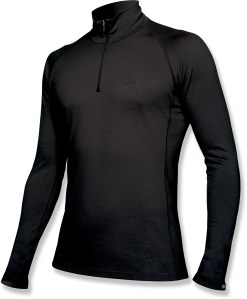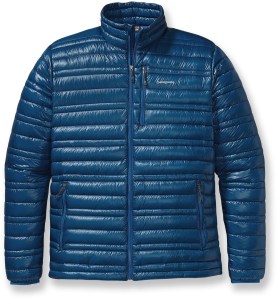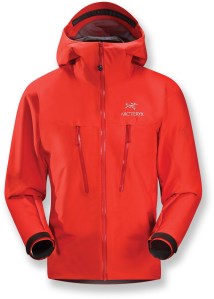So, you bought a fancy Gore-Tex rain shell that the sales guy told you was completely waterproof and you are wondering why you still got wet. The natural conclusion would be that the jacket leaked. Chances are, the water came from you, not the sky. Or you are worried that a soft shell won’t be enough to keep you dry because the manufacturer says that it is “water-resistant” instead of “waterproof.” While that may be true, a soft shell will often keep you drier than a hard shell due to superior wicking and breathablility of a high quality softshell.
While the shell layers may get all the glory, it’s what’s underneath that will keep you warm and move moisture out of the system, or as some manufacturers like to call it, your micro-climate.
A basic layering system consists of 3 parts: base layer, insulating mid layer, and a shell layer to protect your inner layers.
The goal of a base layer is to provide a small amount of warmth, remove moisture, and add comfort to the system. Some common materials used are wool, silk, and synthetics like Polartech and Capilene. Each material has it’s own unique advantages and disadvantages.
Wool is my personal choice for base layers. I’m not talking about scratchy, heavy, uncomfortable wool; a nice, soft, Merino wool base is the best way to go. Wool breaths well, keeps you warm while wet, dries fairly quickly, is lightweight, has anti-odor properties, and can actually help regulate your body temperature. The downside to wool is the price tag. A high quality Merino top can cost around $100. Wool also requires more care than other materials because it can shrink in the wash and lose shape over time.
Synthetics are very comfortable and inexpensive compared to wool. They dry very quickly, have excellent wicking properties, are easy to care for, and they have the best mobility from their ability to stretch. The downside to synthetics is odor control. If you can’t wash your base layers often, they start to stink, unlike wool’s anti-odor properties. The other downside to synthetics is that a higher weight is required for the same warmth as wool. For example, a heavy weight synthetic would be comparable to a midweight wool garment. I would choose synthetics for high output activities when a quick drying garment is your highest priority.
Silk is very lightweight, but it is not very durable. It is very comfortable to wear on crisp days but it’s not the ideal choice for very cold or very warm weather. Silk would be a good choice for someone who is allergic to wool and does not care for synthetic materials.
The fit of base layers can differ by activity, output, temperature, and preference. A good rule here is in warmer weather, aim for an “athletic” fit; something not tight, but not too loose either. A looser fit will help keep you cooler and will still be able to wick moister away from your body. For cold weather activities, the fit should be form fitting and snug, not tight. A slimmer, more form-fitting garment will keep warm air closer to your body for chilly days.
A mid layer should be highly air permeable and highly breathable. What’s the difference? Air permeability is a garments ability to allow air to flow freely through the garment, while breathability is the ability to allow moisture to move through the garment, mostly away from your body. Both are important to have in a mid layer to maintain warmth and dryness and in helping a shell layer maintain it’s breathable properties.
There are many different materials used for mid layers. I will be talking about 3 different kinds: down, synthetic down, and fleece. There are all sorts of combinations out there on the market with different advantages and disadvantages, but we could be here all day talking about those.
Materials in mid layers are almost identical to sleeping bags: lightweight, water resistant nylon over a fill that traps warm air. Down is the premium insulator. It is very lightweight, very warm, and highly compressible. Down has some big downsides when it comes to moisture, however. Down traps water even better than it traps air and it looses it’s insulating value once it get’s wet. Even moisture moving from your body out through your jacket can lessen the warmth of a down jacket. Fortunately, there are some great new water-resistant feathers out there like DownTek and Dry Down that have been treated with a water-resistant coating. Down is not cheap either, but it sure is nice and warm. Down is great for dry climates and lower output activities in cold weather.
Synthetics are a great choice as well. There are all kinds of synthetic fills out there but some are better than others. My personal favorites are Premaloft and Arc’teryx’s Coreloft. Unlike down, synthetics continue to keep you somewhat warm after they get wet, they dry quickly, are highly compressible, are easy to care for, and transport moisture through a layering system very well. Premaloft is as close to down as it gets in the world of synthetics but with even lower bulk and even less loft is needed to trap heat, so don’t be worried when you see how thin Premaloft jackets can be.
Fleece is a great insulator and feels warm right when you put it on. Fleece is basically the same thing as a synthetic base layer bulked up to a mid layer weight and fit. They are highly breathable, wicking, air permeable, and fairly lightweight, but they are very bulky compared to puffy insulated jackets. I mostly use fleece for crisp days or for a second mid layer on very cold days. A bonus to fleece’s bulkiness is that you can use it for a pillow!
There are 2 basic shell layers that most people use: hard shell and soft shell. This is where things get complicated.
Hard shell typically comes in a couple different forms: laminate and nylon. A nylon shell is very simple, usually just a durable water repellent coating (DWR) and nylon. Laminate’s consist of a DWR, a face fabric (typically nylon, this is the part you see), the laminate (this is the part that makes the jacket waterproof), then usually some type of backing material on the inside. The 2 most popular laminates out there are Gore-Tex and EVent.
Nylon hard shells are lightweight and have good water resistance, but they are not very breathable or comfortable next to skin. Nylon by itself is not hydrophobic which is why these jackets are not considered totally waterproof. Most nylon rain jackets have taped seems and are coated in a DWR to shed water quickly. The DWR will eventually wear off and need to be recoated.
Laminates have the highest water resistance and can range anywhere from ultra light to downright heavy. The DWR coating is the first barrier that causes water to bead up and roll of the jacket easily so the nylon face fabric does not “wet out.” Wetting out occurs when you can see the fabric itself absorbing water. The laminate layer is a membrane that works to equalize moisture and pressure. Your shell and your body create a sort of “micro-climate” inside the jacket that has a high pressure and high moisture, if the jacket’s membrane is clean that pressure will push the moisture through the shell to keep you comfortable and dry and not allow any water from the outside to come in. As magical as it sounds, hard shell jackets can be overwhelmed with moisture from the inside which causes a clammy feeling. But I promise, your jacket is not leaking, you are working too hard and the jacket can’t keep up. That is why I recommend hard shell jackets for lower output activities where you may be in the rain or wind for long periods of time and protection from the elements is your first concern.
Soft shells are my personal go-to. I know that they are technically “water-resistant” but it’s not very often that a soft shell will leak. If it does, you should have checked the weather forecast before you went out for the day and packed your hard shell because you were probably standing in the rain for hours on end. I use soft shell garments for climbing, hiking, skiing, and everyday use because they are the most comfortable option. Soft shell jackets do have less wind and water resistance to hard shell and they are heavier. However, most of the time you will stay dryer in a soft shell because of the increased breathability and have better mobility because they stretch. Soft shells are very durable so they are great for climbing and skiing where they will come into contact with rough surfaces and sharp points or edges. Don’t be afraid of the term “water resistant” or the extra weight, a soft shell is the best choice for moving quickly in the mountains, particularly in mixed conditions where wind, rain, and sunny weather are all likely for the day. Some soft shells can even be used as an extra mid layer depending on how air permeable it is.
There are a lot of bad reviews and misconceptions about shell layers out there, many of them being about water resistance. The truth is, if you have a shell layer on and you are wet, it’s probably because you are sweating and your mid layers are not transporting moisture out of the system or your shell is not breathing well. It is highly unlikely that your shell leaked no matter what the material. I know, I know, the material is wet on both sides of the jacket. What almost certainly happened is the outer face fabric “wetted out” and your body’s output of moisture was too much for the shell to let out. So what?! I’m still getting wet! My answer to that is: get a soft shell or stop sweating so much. Each piece has it’s place in your layering system, but 90% of the time, a soft shell will be your best choice.
I hope this article was helpful in building a layering system. If you have any questions or concerns, go ahead and leave a comment for me. If you would like more information, check out http://www.rei.com/learn/expert-advice/dress-layers.html and the rest of REI’s Learn database.




